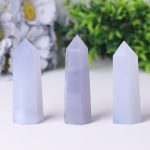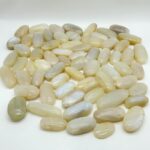Serpentine stone, a captivating mineral that has graced our planet for millions of years, continues to enchant with its enigmatic allure and versatile applications. From ancient civilizations to modern-day jewelry, this unique gemstone has left an indelible mark on human history and contemporary culture.

Serpentine Stone: An Overview
Serpentine is a collective term for a group of minerals mostly composed of antigorite, chrysotile, and lizardite. It belongs to the serpentine group of phyllosilicate minerals. The stone’s distinct appearance arises from its intertwined fibrous structure, giving it a silky to greasy luster and a wide range of hues, including shades of green, brown, red, and black.
Geological Formation and Properties
Serpentine forms through the hydrothermal alteration of ultramafic rocks, such as peridotite and dunite, typically in tectonic plate boundaries where oceans meet continents. This complex process occurs when water interacts with the rocks at high temperatures and pressures.
Serpentine has a Mohs hardness of 4 to 5.5, making it a relatively soft mineral. It is also brittle and can be easily scratched or chipped. However, its flexibility and ability to form intricate patterns contribute to its aesthetic appeal.
Colors and Patterns: A Kaleidoscope of Nature
One of the most striking features of serpentine stone is its remarkable color variations. The presence of different minerals and impurities creates a mesmerizing array of hues, from vibrant emerald greens to deep chocolate browns. The stone’s markings and patterns are equally diverse, showcasing swirls, veins, and inclusions that resemble ancient landscapes or ethereal swirls of color.
Historical Significance: A Journey Through Time
Serpentine stone has been prized by civilizations throughout history. Archaeological evidence suggests that people of the Neolithic era used serpentine to fashion tools and weapons. In ancient Egypt, it was believed to possess mystical powers and was used in jewelry, amulets, and sculptures.
During the Victorian era, serpentine became a popular ornamental stone, gracing everything from decorative objects to architectural elements. Its distinctive colors and patterns evoked a sense of opulence and elegance.
Contemporary Applications: A Versatile Mineral
Today, serpentine stone continues to find widespread applications in a variety of industries.
-
Jewelry: Serpentine’s captivating colors and patterns have made it a popular choice for jewelry designers. Its unique aesthetic complements both contemporary and traditional styles.
-
Decorative Arts: Serpentine is frequently used in decorative art forms, such as sculptures, vases, and bowls. Its intricate patterns and earthy tones add depth and character to interiors.
-
Construction: Serpentine’s durability and fire resistance make it suitable for architectural applications. It is used as a facing material on buildings, countertops, and flooring.
-
Environmental Remediation: The absorptive properties of serpentine are being explored for environmental remediation, particularly in the removal of heavy metals from contaminated soil and water.
Benefits of Serpentine Stone: A Gemstone with Holistic Qualities
Beyond its aesthetic appeal, serpentine stone is also believed to possess various holistic properties. It is said to promote emotional balance, reduce stress, and enhance creativity. Some practitioners of alternative medicine use serpentine to treat digestive issues, skin conditions, and nervous system disorders.
Market Size and Trends: A Growing Demand
The serpentine stone market is expected to continue expanding in the coming years. Increasing demand for natural and sustainable materials in construction, jewelry, and decorative arts is driving growth.
- According to a report by Allied Market Research, the global serpentine stone market was valued at $1.5 billion in 2019 and is projected to reach $2.5 billion by 2027, registering a CAGR of 6.2%.
Serpentine Stone: A Sustainable Option for the Future
Serpentine stone is an abundant and recyclable material. Its use promotes sustainability by reducing reliance on non-renewable resources. The stone’s durability and fire resistance make it an environmentally friendly choice for construction. Additionally, its ability to absorb heavy metals contributes to environmental remediation efforts.
Uncovering the Serpentine Stone’s Potential: A Path to Innovation
The serpentine stone’s distinctive properties present opportunities for innovative applications.
-
Energy Storage: The stone’s ability to absorb and release heat is being explored for thermal energy storage systems.
-
Medical Diagnostics: Serpentine’s optical and electrical properties could pave the way for low-cost and portable medical diagnostic devices.
-
Nanotechnology: The stone’s unique nanostructures could inspire advancements in nanotechnology and catalyst materials.
Serpentine Stone: A Timeless Gemstone with Infinite Potential
Serpentine stone, an enduring treasure from the depths of the Earth, continues to captivate with its ethereal beauty, versatile applications, and potential for innovation. As the world seeks sustainable and aesthetically pleasing materials, serpentine stone emerges as a timeless gemstone poised to shape the future of art, construction, and technology.
Conclusion: A Legacy of Allure and Enduring Value
Serpentine stone, with its enigmatic beauty, historical significance, and versatile applications, has left an enduring mark on human civilization. From ancient temples to modern skyscrapers, from exquisite jewelry to sustainable building materials, this gemstone has played a pivotal role in shaping our world. As we unravel the full potential of serpentine stone, its legacy of allure and enduring value will continue to inspire future generations.




























